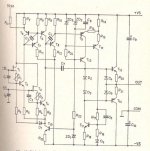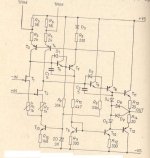BC said:Mr. Wurcer,
Thanks much!
BC
Hey I'm from Milwaukee, my father went to school with Liberace!
We better not ask if you learned to play the piano.
TY for posting these, i recall building some stuff with Burr Brown 3553/3554
(JC spills a lot but never his juice, i think.)
TY for posting these, i recall building some stuff with Burr Brown 3553/3554
(JC spills a lot but never his juice, i think.)
scott wurcer said:
Hey I'm from Milwaukee, my father went to school with Liberace!
Where/ when did you go to High School?
🙂
scott wurcer said:
MUHS class of '68
OT
If that is Marquette Univ. High School, then you were one of those "rich kids". 😀
I graduated form Cudahy High School, '72.
I was a music major, 30yrs. classical music performer/teacher.
Nice to see a Milwaukee boy as one of the world class electronic designers.
🙂
Sorry everyone. No more OT from me.
BC
Re: OK one more
Yep. I remember these babies from the early 80's. If I recall correctly they were in some rectangular metal cans with DIL14 pinout. We used them as I/V for a very high speed DAC. I've built with one of these Teledyne things a low distortion Wien bridge oscillator right up into the MHz range.
I'll dig in the basement, I may have some notes on these hybrids from those times. I recall reverse engineering some as well.
scott wurcer said:Again from Teledyne, this one's really wild, DMOS FET's! Can anyone figure out what the DMOS on the input is doing? It could be some neutralization. 2GHz GBW and 1200V/us. It took years for IC's to catch up to this.
Yep. I remember these babies from the early 80's. If I recall correctly they were in some rectangular metal cans with DIL14 pinout. We used them as I/V for a very high speed DAC. I've built with one of these Teledyne things a low distortion Wien bridge oscillator right up into the MHz range.
I'll dig in the basement, I may have some notes on these hybrids from those times. I recall reverse engineering some as well.
Mr. Wurcer,
What makes it possible for opamps to reach performance like LM4562, OPA827? Is it the process of the semiconductor or the schematic design?
What makes it possible for opamps to reach performance like LM4562, OPA827? Is it the process of the semiconductor or the schematic design?
lumanauw said:Mr. Wurcer,
What makes it possible for opamps to reach performance like LM4562, OPA827? Is it the process of the semiconductor or the schematic design?
A little of each, it's hard to say.
- Status
- Not open for further replies.
- Home
- Amplifiers
- Solid State
- Classic op-amp schematic


